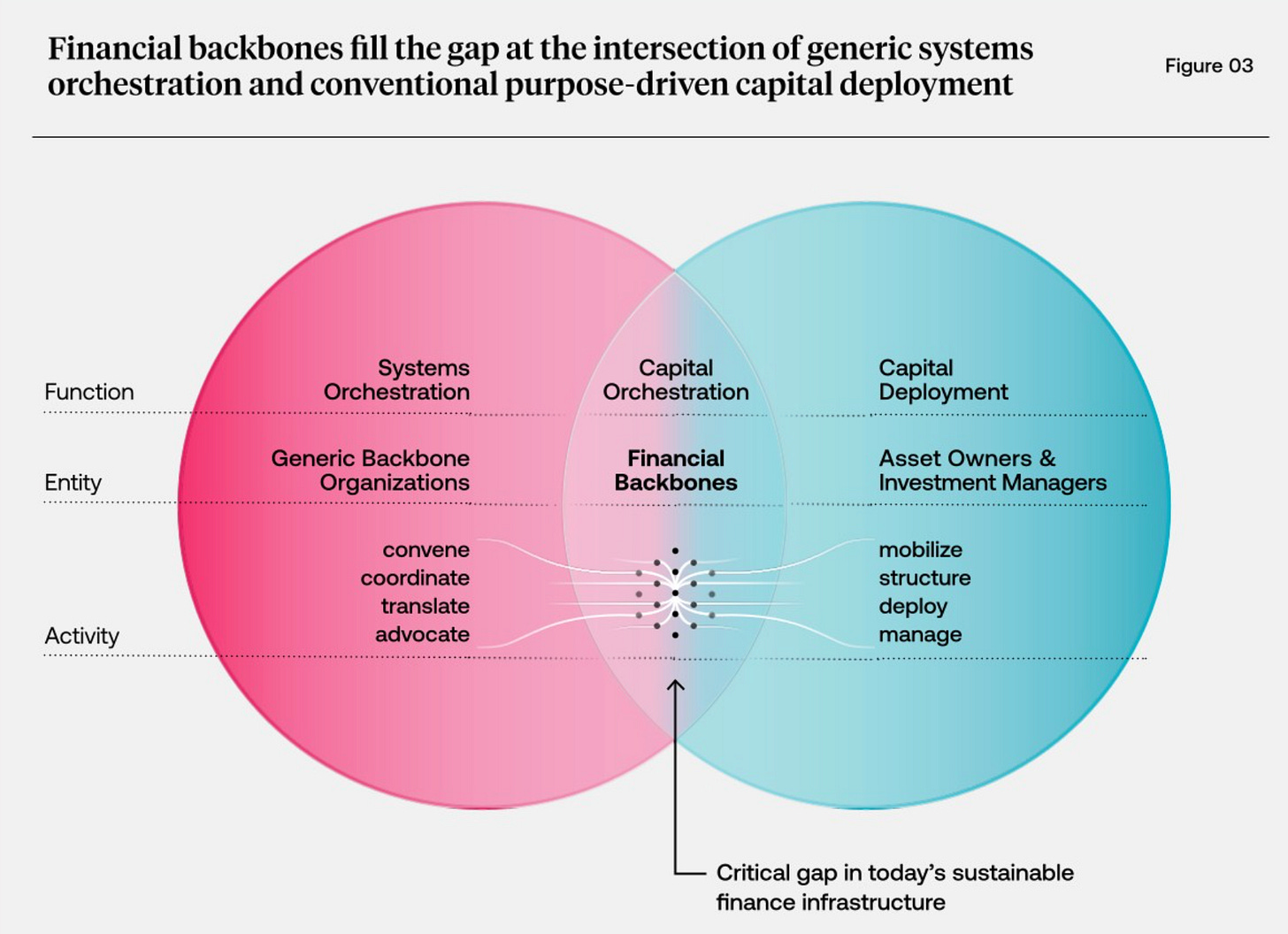Four For Friday | Sept 12, 2025
LF187 | Financial backbones, stealthy longevity, cute robots and Sam Altman's playbook + Nano Banana.
Welcome to this week’s Four For Friday - back in Melbourne in time for spring. In today’s edition, new entities to drive systems change, making healthy longevity seamless, cuddly robots and 13 lessons for life. Plus Google’s insanely powerful new image tool.
1. Financial backbones
A new report by Transformation Capital introduces a new kid on the block in the world of impact, or more specifically purpose-led systems transformation. Let us welcome the ‘financial backbone’, whose job it is to orchestrate financial capital for systems transformation.
The idea sounds dry. It matters. This is often the missing mechanism that drives real change. Many funders still back pet projects. Few invest in field building.
Financial backbones are “entities dedicated to strategically mobilizing, coordinating, and deploying financial capital for catalyzing the transformation of systems”. They fit in the gap between those who are orchestrating systems (often non-profits and coalitions of the willing) and the capital system. The intersection is about those organizations who are able to mobilize capital to do more than just get more capital, but to change the system.
These entities convene coalitions, generate systemic intelligence, and coordinate multiple forms of capital across portfolios and time.
Examples remain scarce but are growing. Regen Melbourne acts as a collaboration engine for the regeneration of Greater Melbourne. ReFED works to cut US food waste by 50 percent.
These entities map leverage points, shape pipelines, structure instruments, and broker deals while building capacity and accountability. The goal is strategic, integrated, contextual deployment of grants, concessional funds, commercial capital, and policy tools. The field is still struggling because mandates, incentives, skills, and funding are misaligned, but the need is growing ever more acute.
The So What? ‘Backbones’ are infrastructure, not projects - and those looking to fund systems change need to embrace funding this kind of infrastructure (don’t call it overhead), rather than just the shiny projects themselves.
2. Stealthy longevity
A couple of related articles about the trend of longevity data and insights blending into the background, and thereby becoming more effective.
Hilary Lin of Care Core suggests we’re going to be seeing ‘invisible integration’ - of devices and services that seamlessly blend into our daily lives. She cites Ultrahuman, Withings and consumer products (think shampoo) that integrate personalized longevity outcomes without you having to give it much thought.
That concept is aligned with the idea of stealth mode in Fitt Insider, arguing that we’re on the cusp of invisible diagnostics. Examples include Throne (which just raised $4m for bathroom diagnostics), Lura, Feno and Comma. The piece concludes suggesting a shift towards clinical-grade capabilities with consumer-grade design: “The next unicorns won’t be wellness devices — they’ll be reimbursable diagnostics with lifestyle-level UX.”
The So What? Part of the mega shift in healthcare away from the cathedrals where patients come to pay homage to superstar doctors, and towards community-based, preventive first solutions that will be needed to reduce healthspan disparities.
3. Cuddly robots
Despite an exciting (and rare) funding round for a female-led, Australian humanoid robot company, and the noise about Teslas humanoid robots, some of the more interesting developments with robots that care are coming from things that don’t look human at all.
Recently at the Osaka Expo I met with the team behind Scottish robot startup, Kompanion, which is framing its opportunity as less human replacement and more interior design:
“Powered by a newly-developed AI system capable of learning and expressing meaningful emotions through body language and sound, ‘Maah’ replicates animal empathy beautifully. Unlike robots that offer poor attempts at conversation, Maah plays with your senses and bonds with humans through more natural, non-verbal communication.”
Casio has gone in a similar direction recently with their Moflin pet robot, which they acquired after its successful Kickstarter campaign.
The So What? Some signals of a trend around new shapes - and textures - of robots.
4. Sam Altman on how to be successful
Sam Altman’ hacks for life - which he wrote seven years ago - are still on point. Before he became one of the most influential people shaping our collective futures he created this list, and they all hold true today. Here’s the cliff notes - worth a read:
Compound yourself: Exponential growth beats linear progression always.
Have almost too much self-belief: Conviction separates the winners.
Learn to think independently: Original thinking cannot be taught traditionally.
Get good at "sales": All careers become evangelizing your vision.
Make it easy to take risks: Small bets, asymmetric upside potential.
Focus: Force multiplier trumps working many hours.
Work hard: 99th percentile requires both smart and intense.
Be bold: Hard startups easier than easy ones.
Be willful: World bends to persistent, optimistic pressure.
Be hard to compete with: Build unique leverage, avoid mimetic behavior.
Build a network: Great work requires talented team collaboration.
Get rich by owning things: Equity scales, salaries don't compound exponentially.
Be internally driven: External validation prevents truly interesting work.
The So What? History is generally written by the winner, but these have really stood the test of time. And significantly, I liked that this didn’t refer to “AI” once.
Bonus AI Tip of the Week: Nano Banana
In a sign that Google’s still got some mojo, its delightfully named Nano Banana (look for the Create Image option in Google Gemini) is an insanely good image editor. Here’s a pic from a recent 5x5 meetup in London with Eric and Aaron…
which in a few seconds is transformed to one from somewhere more exotic…
That’s all for now - happy weekend everyone.
- Stephen






